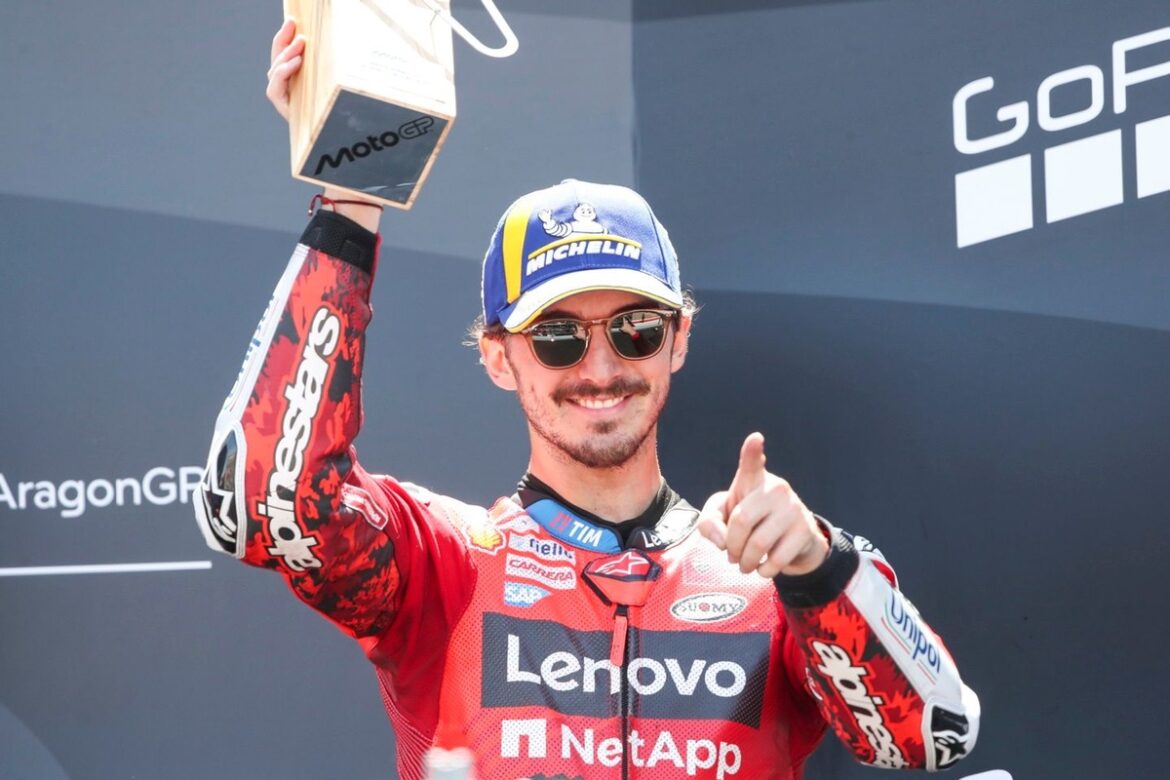Francesco Bagnaia’s Comeback: A Look at His Journey and the Changes That Made a Difference
Francesco "Pecco" Bagnaia, the talented rider for the Ducati Lenovo Team, has experienced a rollercoaster of emotions throughout the MotoGP season. After securing a podium finish in three out of the first four races—including a remarkable victory in Austin—Bagnaia found himself in a challenging phase, particularly after the French Grand Prix, where he finished 16th. This period of struggle continued in the British Grand Prix, where he faced a crash, and then further disappointment in the Aragón sprint, where he dropped several positions to finish 12th.
Recognizing the need for a turnaround, Bagnaia reached out to his team for assistance, urging them to engage in discussions to identify solutions. His efforts culminated in a triumphant return to the podium, where he secured a commendable third place finish, trailing behind the dominant Marc Márquez and the consistent Alex Márquez. During the race, he successfully defended his position against intense pressure from rising star Pedro Acosta.
In an exclusive interview with Motorsport.com, team manager Davide Tardozzi shared insights into the adjustments made to help Bagnaia regain his competitive edge. "A minor change was essential to restore his confidence in braking," Tardozzi stated, highlighting the modifications made to the brake system, particularly the brake discs. This adjustment proved to be a significant factor in Bagnaia’s performance resurgence.
Understanding the Unique Challenges of the Aragón Circuit
The Motorland Aragón Circuit presents a unique set of challenges for MotoGP riders, particularly concerning braking. Statistics indicate that riders apply brakes throughout 29% of the lap, with Brembo categorizing the level of brake disc stress as ‘hard,’ rating it 4 out of 6. Despite this demanding environment, most competitors typically opt for a 340mm diameter front disc on their machines.
However, Bagnaia’s team took a different approach by utilizing 355mm diameter brake discs, a modification that only he employed during the Aragón race. This seemingly small change resulted in substantial improvements in performance, leading to questions about whether this resurgence marked a permanent shift or merely a temporary boost.
Tardozzi expressed optimism regarding Bagnaia’s newfound understanding of his bike’s dynamics. "I believe we have grasped some crucial insights, and Pecco has as well," he remarked. He indicated that further evaluations would take place during the official test scheduled for the following Monday at Motorland, where Ducati aimed to roll out additional enhancements.
Innovations on the Horizon
Looking ahead, Ducati’s plans included not only the introduction of a new aerodynamic package but also the testing of various components that Bagnaia had previously set aside for consideration. Tardozzi noted that Márquez had already begun utilizing some of these features, suggesting that Bagnaia would be encouraged to reassess them in hopes of achieving even greater performance improvements.
After the race, fellow rider Fabio Di Giannantonio learned about Bagnaia’s successful use of the 355mm disc and decided to equip his own bike with this enhancement during the upcoming test. This collaborative spirit within the Ducati team exemplifies the camaraderie and shared pursuit of excellence that characterizes the MotoGP paddock.
The Importance of Team Support
Throughout this challenging phase, the unwavering support from the Ducati team has played a pivotal role in Bagnaia’s journey. Tardozzi emphasized that at no point did the team falter in their commitment to assist Bagnaia in overcoming his difficulties. The collaborative efforts and open communication within the team are vital elements in fostering a conducive environment for success.
As the MotoGP season progresses, the dynamics of racing continually evolve, and adaptability becomes essential. The ability to identify areas for improvement and implement effective changes is crucial for riders like Bagnaia, who aim to maintain their competitive edge amid fierce competition.
Bagnaia’s Path Forward
With the recent podium finish serving as a morale booster, Bagnaia’s focus will be on leveraging the insights gained from the Aragón race to build momentum. The upcoming tests will be critical in assessing the effectiveness of the changes made, and the entire Ducati team will be eager to see how these adjustments translate into performance on the track.
As the team prepares for future races, the emphasis on continuous improvement and innovation will be paramount. Bagnaia’s willingness to embrace change and seek solutions, combined with the support of his team, sets the stage for what could be a remarkable comeback in the latter half of the season.
Conclusion
In the high-stakes world of MotoGP, where every fraction of a second counts, the interplay between rider performance and team strategy is crucial. Francesco Bagnaia’s journey through the ups and downs of the season highlights the importance of resilience, teamwork, and the willingness to adapt. As he looks ahead, the lessons learned from the challenges faced at the Aragón Circuit will undoubtedly shape his approach in the forthcoming races, reaffirming his status as a formidable competitor in the world of motorcycle racing.
